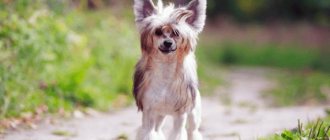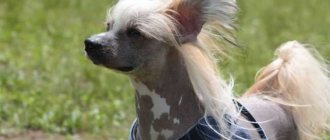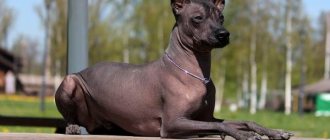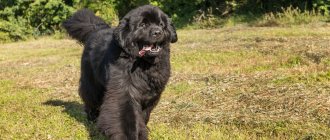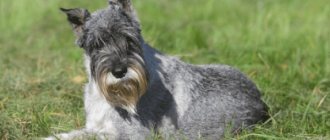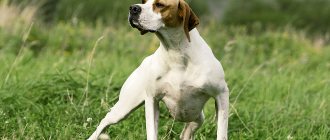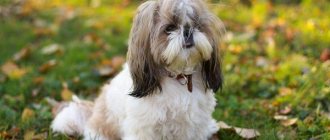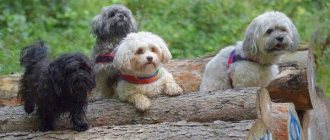The Chinese Crested dog breed is a real star in the world of four-legged decorative exotics. Centuries-old selection has given the world an extravagant appearance and a pronounced focus on humans.
Delightfully graceful miniature dogs with a dashingly fluffed forelock on their heads and intelligent (slightly languid) eyes involuntarily attract attention, causing constant delight.
Description and features
Based on the name of the breed, it is easy to conclude that it is popular primarily in China. In this country, the dog is treated like a mascot. It is believed that if you bring a small crested cat into your home, prosperity and prosperity will appear there.
These animals are also popular in most European countries. The main feature of the Chinese Crested dog is its unusual appearance. Her skin is almost bare, and on her head there is a mane of smooth and pleasant to the touch wool.
This breed is very ancient, and the history of its discovery is full of secrets and mysteries. According to a popular version, in ancient times an African breeder came to China to breed hairless dogs.
Presumably, this breed appeared around 1000 BC. e. In ancient times, its representatives were treated with great respect. They were pampered, loved and even idolized.
The Chinese crested dog had a special “home” purpose - to warm the owner during sleep. Despite the almost complete absence of fur, the skin of such a dog emits a large amount of heat.
Residents of the ancient world believed that the owners of such pets got sick less and lived longer. Crested dogs were credited with medicinal properties, and people also believed that these dogs had psychedelic effects, that is, they could influence people’s mood.
Interesting ! Modern Indians insist that Chinese crested dogs have miraculous properties. In their opinion, these animals are able to relieve human toothache, relieve insomnia and cure rheumatism.
Thanks to Asian sailors, the world learned about representatives of this breed in the 16th century. They were standardized only in the second half of the 20th century. Despite the fact that these wonderful animals were brought from Asia, England is considered their homeland. Why? It was in this country that clubs for Chinese Crested lovers first appeared and began actively breeding dogs there.
Despite its cuteness and diminutive size, inside such an animal there is a lion dormant. It is proud, strong and very resilient. Many people underestimate the power of decorative dogs, but in vain. The Crested is one of the best companion dogs. She quickly and for a long time becomes attached to one person, preferring to be near him all the time. But sometimes she likes loneliness.
Origin story
Cynologists do not have a single version of the origin of the animal. Scientists believe that the breed originated from Mexican hairless dogs, which are about four thousand years old. In some historical works dating back to the 16th century, there are fragmentary references to crested dogs.
The animals were often taken on voyages by Chinese traders. The dogs hunted rats and other small rodents that could spoil the goods. Sailors from Africa, India, Turkey and Malaysia also had four-legged travelers.
The popularity of the breed grew especially strongly in the 18th and 19th centuries. The crested dog was depicted in paintings by famous masters: Jacques-Laurent Agas and Adrian van Utrecht. Dogs often became the heroes of articles and books.
In the mid-20th century, the breed received official recognition from the Fédération Cynologique Internationale (FCI) and the American Kennel Club (AKC). In Russia, crested downy dogs are very popular among breeders. Breeding animals from the Russian Federation constantly become winners of international exhibitions.
Breed standard
Decorative dogs are notable for their small size and weight. The Chinese Crested breed is characterized by the absence of hair on almost all parts of the body. The maximum permissible weight for its representatives is 5 kg. Some miniature bitches weigh no more than 2.5 kg. Height at withers – from 27 to 32 cm.
The animal's build is stocky. His torso is stretched forward, his stomach is strongly tucked. Hairless representatives of the breed have clearly visible ribs on their bellies. The sternum is wide, slightly protruding. The dog's paws are thin, graceful, elongated. The front ones are shorter. The tail is long and cannot be docked. Is mainly in a supine position.
A stop is clearly visible on the crested head - the transition of the forehead to the muzzle. The frontal line is wide, and the oral line is elongated. The dog has an excellent bite. The mouth has white sharp teeth. By the way, they often fall out for anatomical reasons. A dog with missing front teeth is not eligible to participate in any competition and will be disqualified.
The Chinese Crested in the photo looks inquisitive and interested. This is due to the unusual shape and structure of her eyes. They are large, almond-shaped, and protrude slightly.
The iris is most often black or brown, but in representatives of the breed with light skin it can be sandy or cream. Less commonly, such dogs are born blue-eyed. According to the standard, the iris of each eye should be monochromatic.
The ears of crested cats are large and erect. They have delicate fur. Hair is also present on the tips of the dog's legs, tail and back of the neck. Exhibition representatives of the breed are regularly clipped. Sometimes their fur is smoothed with an iron.
Chinese Shar Pei
- Height: from 45.7 to 50.8 cm
- Weight: from 20.4 to 27.5 kg
- Life expectancy: 8 to 12 years
- Average cost: from 1000 to 1500 dollars
The Chinese Shar Pei was also developed during the Han Dynasty, but has a more troubled past than the Chow Chow. The breed was on the verge of extinction in 1949 when the communist regime after the founding of the People's Republic of China opposed dog ownership. Fortunately, the Chinese Shar Pei survived and was officially recognized in 1992.
The Chinese Shar Pei performs best when it can make its own decisions, so it is important to prioritize obedience training with positive reinforcement to help your pet respond correctly to your cues.
Along with their blue-black tongue, these dogs are also famous for their wrinkled appearance. They should be bathed monthly and the folds between the wrinkles should be kept dry and clean. Ear cleaning is a priority and should be done weekly using a cleaning solution recommended by your veterinarian.
Kinds
The most common is hairless, that is, hairless Chinese Crested. But there is another type of breed - downy. Let's look at each of them.
- Naked. The fur of the animal on the top of the head folds into a small tuft - hence its name. The hair on the tail is straight and forms a “tassel”. At the tips of the paws, it should also not be wavy, it resembles boots. This individual has no undercoat. The dog's skin is very delicate and almost always warm. Show-class dogs should have thick head fur so that they resemble small lions.
- Downy. The main difference between this type of breed is the presence of thick fur throughout the body. There are few such dogs. The fur on the body and tail is stiffer. Downy crested cats have an undercoat. It needs to be looked after regularly.
As for the requirements for the color of the skin and fur of such a dog, there are none. It may have small gray spots on its pinkish-white body. This is acceptable according to the standard. The downy representatives of the breed often have black, white and gray-beige hairs. Less commonly, they are born with brown markings.
Tibetan Terrier
- Height: from 35.5 to 43.2 cm
- Weight: from 8.2 to 13.6 kg
- Life expectancy: 15 to 16 years
- Average cost: from 1000 to 1500 dollars
Referred to as the "sacred dog of Tibet" , this Chinese dog has been associated with ancient Buddhist monasteries and the Dalai Lama, serving a variety of roles as companions, watchdogs and shepherds. They are believed to be native to the Lost Valley of Tibet.
Fun fact: the Tibetan Terrier is not actually a terrier at all. This name was given by European travelers who felt that this breed was very similar to European terriers.
The Chinese believe that the Tibetan Terrier brings good luck . Of course, anyone who owns one of these long-haired beauties feels lucky, as they are a highly adaptable breed well suited to family life. Tibetan Terriers thrive on human contact and make excellent therapy dogs.
With a protective double coat of fur and large, flat, round feet that provide excellent traction—almost like snowshoes—Tibetan Terriers are well suited to life in snowy regions.
Character
The small hairless dog, originally from ancient China, is the ideal home companion. He quickly becomes attached to a person who is affectionate with him. He does not tolerate aggression towards himself. Sensitive to the mood of each household member. He is devoted to them, prefers to always be nearby.
Living with such a pet is a great pleasure. He will never demand from a person what he cannot give him. Affectionate, gentle and very loving. He treats people from his family with reverence.
Such a dog is completely devoid of malice. She is completely ineffective as a security guard and bodyguard. Even if an armed robber comes to your house, she will warmly welcome him.
This cute animal was created exclusively for love and tenderness, but not for aggression and suspicion. True, there are situations that can greatly agitate him, for example, family quarrels, screaming.
Being in an unfavorable psychological environment, the dog will find a secluded place and wait out the “storm” there. Usually he stays close to his owner, but if he is in a state of anger or strong malice, he will leave him and retire.
They say that the Chinese Crested is a mood dog. She spends most of the day next to her loved ones, accompanying them everywhere. Well, as soon as something affects her mood, she will leave them to be alone. Sharp mood swings are typical for representatives of this breed.
The second special character trait of such a dog is curiosity. In a home or outdoor setting, he feels like an explorer of the world. He likes to sniff out the ground, living things, including dogs, objects on the floor, etc.
Good nature and a gentle attitude towards living beings helps the crested cat to socialize without problems in an apartment in which pets already live. Rest assured, even without your intervention she will get along with everyone!
When guests arrive, they may show shyness. When a person who comes to the house speaks affectionately to a cute hairless dog, it will melt her heart, and she will definitely come up to receive a portion of attention from him.
But the dog avoids unfriendly and rude strangers. She frankly doesn't like them. A pampered animal requires affectionate treatment, care and attention. Without this, he becomes very nervous, sad and can behave apathetically.
The Chinese Crested has one more feature - excellent mental abilities. The breed is incredibly savvy. Such a dog always understands if his owner is upset about something. He is trying to be close to him at this moment. And if the owner is joyful, then the dog is also present near him to share this emotion.
Pug
- Height: from 25.4 to 33 cm
- Weight: from 6.3 to 8.2 kg
- Life expectancy: 13 to 15 years
- Average cost: from 800 to 1500 dollars
Many people are often surprised to learn that the pug is a Chinese dog. The breed probably dates back more than 2,000 years ago . Pugs were bred as companions to Buddhist monks, and emperors and royalty kept pugs as valued family members. Today, due to their affectionate nature and funny appearance, pugs continue to be the ideal family dog.
Fun fact: The Pug's motto is the Latin phrase "multum in parvo" ("much in little") - an apt description of this small but muscular breed.
Pugs are always happy, whether they live in the city or in the countryside, with children or the elderly, kept as the only pet or have four-legged friends. Pugs naturally do not tolerate heat well and should not exercise in warm or humid weather.
Care and maintenance
Caring for a hairless representative of the breed is more difficult than caring for a downy one. Delicate skin requires care and regular cleaning. This pet bathes every week! It is important to choose the right shampoo for him.
It is desirable that it does not contain aggressive chemical elements. We recommend buying a simple tar shampoo for your Chinese Crested (preferably for decorative dogs with delicate skin).
For exhibition animals, the use of moisturizing conditioners is also recommended. An additional care product is nourishing body milk. It contains vitamins and nutrients for the epidermis.
Such a dog must have his own towel. It is advisable to use soft, terry cloth. Dry her body after every bath. But you cannot use alcohol wipes to wipe the body of such a dog. This will cause him to develop severe skin itching.
What else does the owner of a Chinese Crested need?
- Pukhoderka. It is advisable to use such a tool not only for downy dogs, but also for hairless representatives of the breed.
- Massage brush with natural bristles.
- Metal pet comb (only for long-haired animals).
- Toothbrush with hard bristles. Every day, it should be used to remove plaque that forms in the dog’s mouth, regardless of food intake.
The owner of a Chinese Crested can trim it himself. To do this you will need an epilator or a specialized hair cutting machine. As for organizing a comfortable life for a dog, it needs a small and comfortable corner. You'll have to buy a soft lounger. It is easy to train a puppy to sleep on it. You can lay a sheet next to him, saturated with the smell of his mother.
You should not place your dog's bed next to a radiator or window facing the sunny side of the street. So he can overheat and get sick. Most owners of this breed allow it to sleep nearby, that is, on the sofa or bed. This is not a problem.
Tibetan mastiff
- Height: from 61 to 66 cm
- Weight: from 32 to 68 kg
- Life expectancy: 10 to 12 years
- Average cost: from 2000 to 6000 dollars
Many Tibetans believe that Tibetan mastiffs are the receptacle for the souls of monks and nuns who were not reborn as humans or did not enter the heavenly kingdom. Impressively large in size, this Chinese dog was primarily used to guard Himalayan villages and their inhabitants. This breed is said to have protected Alexander the Great and even the Dalai Lama!
Fun fact: the most expensive dog is the Tibetan Mastiff, which sold for almost $2 million in 2014.
a status symbol in China and is therefore one of the most expensive dog breeds. But, despite the thick double coat, Tibetan mastiffs do not require as much care as other breeds, but have a strong shedding season in spring or summer.
Nutrition
Your Chinese Crested puppy must drink pasteurized milk every day. At 5-6 months they stop feeding him this product. During this period, his body will be enriched with calcium, his skeleton will become stronger and his immunity will improve.
After the baby matures, he is gradually transferred to dry food. You can add a little canned food or any food for dogs to boiled cereals. But it must be of high quality! Be sure to pay attention to the composition of such products.
Advice ! We recommend choosing a bowl with a tripod for your pet. It is easy to raise and lower. Adjust the height based on your dog's height. The bowl should be slightly below his muzzle for comfortable feeding. Breeders insist on providing the dog with a balanced diet. She should be given:
- Fresh fruits and vegetables.
- Bone cartilage.
- Boiled porridge.
- Soups and borscht.
- Cottage cheese.
Eating crested baked goods and sweets is unacceptable. You cannot overfeed such a dog!
Taiwanese dog
- Height: from 43 to 52 cm
- Weight: from 12 to 18 kg
- Life expectancy: 10 to 13 years
- Average cost: $3,000 to $4,000
This is one of the rarest dogs on our list. At one point, this Chinese dog breed was on the verge of extinction due to insufficient conservation efforts, which were exacerbated by the dog-eating culture introduced by the Chinese Nationalist Party in 1945. Today, purebred Taiwanese dogs are rare and are mostly limited to Taiwan to preserve the breed. However, many crossbreeds can be found freely in markets.
Reproduction and lifespan
Let us immediately note that only representatives of one breed species should be knitted. If you are allergic to dog hair, then your choice should be the Hairless Chinese Crested. Since these are peaceful and not at all aggressive creatures, they quickly become attached to each other, so there are usually no difficulties in their mating.
Both parents should have a lush crest of delicate wool on the top of their heads. This is the main sign of a purebred individual. They mate a male and a female on the 3rd day of her heat, because the probability of conception is so high.
A pregnant female dog becomes more tender. During 2-2.5 months of bearing offspring, she requires a lot of attention and care from household members. You cannot force a pregnant bitch to walk a lot, this will tire her. The average life expectancy of such dogs is 15 years. Some of them live up to 16-17 years, of course, with good care.
Japanese Chin
- Height: from 20.5 to 28 cm
- Weight: from 3.2 to 5 kg
- Life expectancy: 10 to 12 years
- Average cost: from 1200 to 2000 dollars
Yes, you read that right! Despite its name, the Japanese Chin is believed to have originated in China and long flourished among Buddhist monks and emperors. Its introduction to Japan ultimately shaped the breed as we know it today.
The Japanese Chin is a cute lap dog with a calm disposition . It is well suited for apartment living. Companionship is what Japanese Chins were bred for. They will be happy to spend the whole day next to you or on your lap.
Price
There are not many good kennels in Russia where these dogs are bred. But, there are 2 for sure. One is in Moscow, and the second is in St. Petersburg. The cost of an animal depends on its breed.
Hairless individuals are 2 times more expensive than long-haired ones. The price of a Chinese crested cat (hairless) with documents and pedigree is 30-50 thousand rubles. Puffs are sold for 15-25 thousand rubles.
Breeders working outside of kennels sell such dogs cheaper, from 10 thousand rubles. It is important to distinguish a purebred representative of the breed from a mongrel. Remember, the first one has a delicate tuft on the top of its head.
How to choose a puppy
It is advisable to involve an experienced dog handler when purchasing a KHS decorative breed puppy. You should choose a pet only from professional nurseries.
First, inquire about the breeder's reputation. Immediately before purchasing, familiarize yourself with the parental pedigrees, look at the living conditions, and study in detail the appearance and hereditary habits of the puppy.
Choose an animal based on appearance and behavior. A playful, outgoing baby with a well-groomed appearance, a cool nose and sparkling eyes will be an excellent companion for your family.
The cost of a puppy is influenced by the presence of parental titles and the degree of compliance with the standard. The average price for a small puff ranges from $300 to $800. Experienced dog breeders recommend buying puppies no older than 4 months.
Education and training
Don't rush to introduce your young pet to the outside world before he has been vaccinated. After the last vaccine, at least 2 weeks should pass, or better yet a month, before he goes outside. Why is it important? During this period, his body will develop antibodies to viruses and pathogens with which he will come into contact on the street.
Even if you have taught your Chinese Crested to go to the toilet in the litter box that is in the apartment, you will still have to take him outside. This is done for socialization. The animal must normally “enter” its society, it must learn to interact with other dogs.
To do this, he will need your help. When getting to know the outside world, it is important for the dog to understand that he is surrounded by your care. While walking, do not let anyone offend him. The pet should be picked up if dogs bark at it. This way he will understand that the owner is his protector and support. This is a very important awareness for the socialization of a decorative dog.
It is a mistake to think that a small four-legged pet cannot become a source of big problems. Chinese Cresteds have very strong teeth, with which they can bite people hard, while playing, of course. If the dog begins to bite you in a playful impulse, do not ignore it. You can shout at him or lightly slap him on the body. But don’t even think about hitting the animal!
These are playful and very funny dogs. They easily learn simple and complex commands, but they prefer fun games in the fresh air to boring training. The Chinese Crested loves to bring a plate to its owner, which he throws far ahead. She also likes to swim, run with children, lie in tall grass, etc.
Important ! To prevent your dog from getting sunburn, lubricate its skin with a cream with ultraviolet protection. There is no specialized training program for indoor dogs.
These are pampered and reverently related to all living creatures, who are bred, as they say, for the soul. But this does not mean that you can ignore the issue of raising a decorative dog. The Crested needs to be taught:
- Come when called.
- Don't shit in the house.
- Don't bite.
- Behave unobtrusively with guests.
- Always obey the owner.
Such an animal is suitable not only for young people, but also for older people who want to surround themselves with the attention of a cute four-legged pet. We recommend walking with him away from transport, as his natural curiosity can play a cruel joke.
It is difficult for drivers to notice the small gray-skinned dog that blends into the highway. Many Chinese Cresteds fall under the wheels of cars due to their excessive curiosity.
Such an animal must have a long leash. You can unfasten it only in nature or in a quiet secluded place, away from roads. The dog must know its name and always respond to it.
To teach her this, lure her with a treat and say the name out loud. This way the animal will develop the attitude that I will receive a treat for going to the owner when he calls me.
The Chinese Crested is a gentle, friendly and sensitive creature that needs love and care. You need to teach her anything consistently and patiently. You should never raise your voice at her, try to humiliate her or hit her. The animal will not forgive anyone, even its beloved owner, for physical or mental insult.
Pekingese
- Height: from 15.3 to 23 cm
- Weight: up to 6.5 kg
- Life expectancy: 12 to 14 years
- Average cost: from 750 to 1500 dollars
Legend has it that Buddha created the Pekingese by shrinking a lion. Well known for its regal mane and fluffy fur, the Pekingese was considered sacred by the imperial family of the Tang Dynasty in the 8th century.
Fun fact: Pekingese are named after Beijing. Initially, only members of the royal family could own them, and theft was punishable by death.
An inflated ego is still present in the breed today, and the Pekingese is sure to become the king or queen of your home. Since the Pekingese is a brachycephalic breed , it is important to keep it away from the heat. Veterinarians recommend taking an ice pack or a portable fan with you on walks in the summer to cool your four-legged friend.
Possible diseases and methods of treating them
Periodically, the dog undergoes the process of changing teeth. It is advisable to see her at a veterinarian at this stage. This usually occurs at 4-5 months. Some of the crested teeth sit deep in the gums and are difficult to fall out.
But the renewed body quickly pushes out the old one, causing the dog to experience severe pain. Only a specialist can help him. He will remove old teeth and tell you what liquid should be used to wash the wounds formed in the dog’s mouth. The skin of a hairless Chinese crested cat is its vulnerable spot. In winter it should be insulated, and in summer it should be lubricated with cream with ultraviolet protection.
The oral cavity of such a dog is often affected by pathogens. The fact that an animal has diseased teeth or gums is evidenced by its constant whining. Also, a sick dog refuses food, because he knows that chewing will increase pain.
The best prevention of dental diseases in crested cats is regular oral cleaning. The brush should have hard bristles, as it removes plaque well. By the way, only hairless representatives of the breed are prone to these ailments. In this regard, puffs are stronger and healthier.
Your dog should be vaccinated regularly. It has been scientifically proven that systematic vaccination of purebred dogs increases their life expectancy. Animals get sick less often and last longer.
Tibetan Spaniel
- Height: from 21 to 26 cm
- Weight: from 4.1 to 6.8 kg
- Life expectancy: 12 to 15 years
- Average cost: from 1500 to 3500 dollars
The Tibetan Spaniel is another very old Chinese dog breed, and it's not actually a spaniel either! Bred in the Himalayas almost 2,500 years ago, the Tibetan Spaniel was one of the best watchdogs of Buddhist monasteries. Despite his small stature, the Tibetan spaniel did his job well - the dogs sat high on the walls and barked loudly when strangers approached. Thanks to its innate protective instincts, the Tibetan Spaniel will be an attentive and excellent protector of the home.
Shih Tzu
These dogs are of Tibetan origin, their name translates as “lion cub”. It is unknown from which breeds the Shih Tzu originated; according to legend, these dogs were given to the Chinese Emperor by the Dalai Lama, which is why for many years these dogs were bred only in the imperial family.
The Shih Tzu's coat differs from other dogs in its luxury and silkiness, and the hair on the head resembles chrysanthemum petals.
Shih Tzus are very positive dogs, they never bite, and express their protest with loud barks. They belong to long-lived ornamental breeds, the average life expectancy is 14-17 years .
Full description: Shih Tzu
Chow chow
These dogs were popular both in the imperial family and among ordinary Chinese. A distinctive feature of these dogs is their blue tongue , and in some Chinese regions these dogs are considered edible. They have a leonine appearance and royal calm.
These dogs have an unusual character, they are leaders by nature and not everyone will be able to find a common language with them, but if this happens, the dog will feel the mood of the owner and have a hard time experiencing family conflicts. This is the only dog breed whose diet should not contain meat; it should be replaced with fermented milk products.
Full description: Chow Chow
Xiaxiquan
- Height: from 43.2 to 50.8 cm
- Weight: from 10 to 30 kg
- Life expectancy: 12 to 14 years
- Average cost: unknown
These hunting dogs from China's southern Guizhou province are another Chinese dog breed that is critically endangered , with fewer than a few hundred left in the area today. Xiaxi Quan dogs were a respected breed, primarily used as hunting and guard dogs. They were also considered good luck talismans that brought wealth and prosperity to the homes of their owners.
